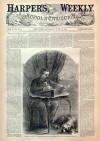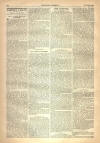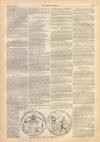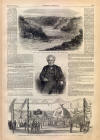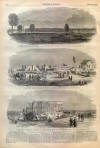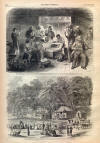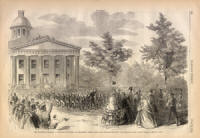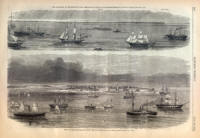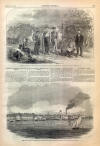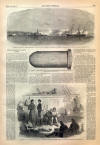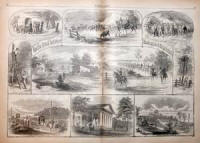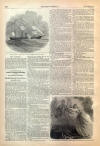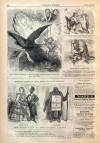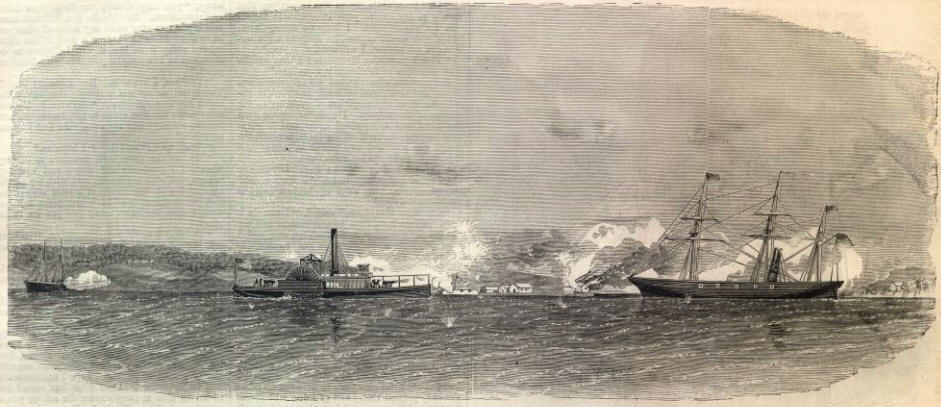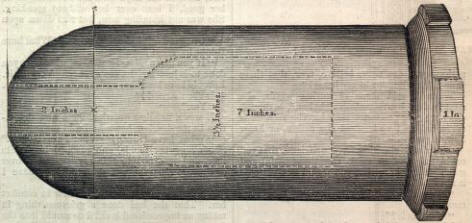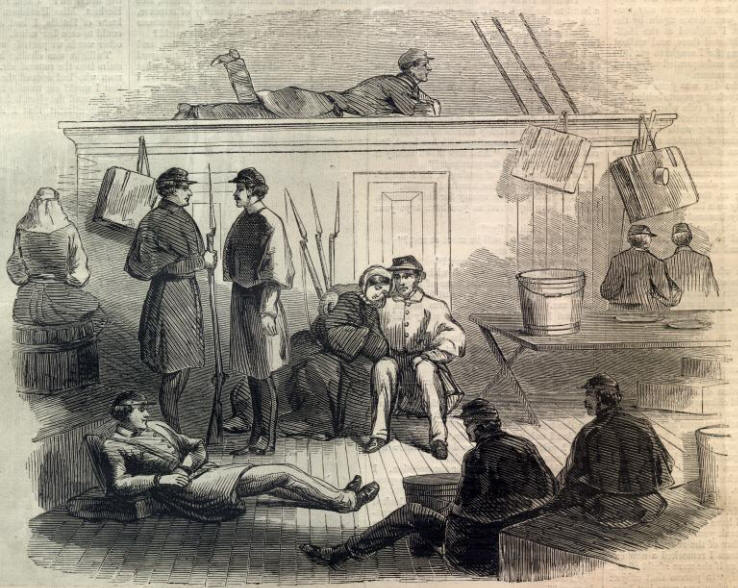|
This Site:
Civil War
Civil War Overview
Civil War 1861
Civil War 1862
Civil War 1863
Civil War 1864
Civil War 1865
Civil War Battles
Confederate Generals
Union Generals
Confederate History
Robert E. Lee
Civil War Medicine
Lincoln Assassination
Slavery
Site Search
Civil War Links
Civil War Art
Revolutionary War
Mexican War
Republic of Texas
Indians
Winslow Homer
Thomas Nast
Mathew Brady
Western Art
Civil War Gifts
Robert E. Lee Portrait
|
ACTION AT ACQUIA CREEK BETWEEN
UNITED STATES VESSELS AND REBEL BATTERIES.-[SKETCHED BY LIEUTENANT CASH DURING
THE ACTION.]
FACSIMILE OF A SHOT FIRED AT
THE "THOMAS FREEBORN" FROM THE ACQUIA CREEK BATTERIES—HALF THE ACTUAL SIZE.
BOMBARDMENT OF ACQUIA
CREEK.
WE publish herewith, from a
sketch by Mr. THOMAS M. CASH, of the Freeborn, a picture of the recent
engagement between the Pawnee, Freeborn, and the Anacosta on one side, and the
Acquia Creek batteries on the other. Mr. CASH was engaged in the battle, and his
sketch may be relied on. The following account of the battle may serve to
explain it:
On Saturday the fight, which was
temporarily abandoned for want of ammunition on board the United States vessels
on Friday, was resumed at half past eleven o'clock in the morning, and continued
until half past four that afternoon without intermission. The guns in the rebel
batteries mounted on the heights had been removed to the beach during the
previous night, and upon that point the fire of Saturday was directed by the
Freeborn, Anacosta, and Pawnee, which hauled inshore, and kept up an incessant
fire for five hours, until the men were worn out from fatigue.
Captain Ward reports that upward of a thousand
shots were fired by the rebel batteries, and that a hundred at least struck on
or close around the Freeborn, some of them damaging her hull so that she leaked
considerably, and some hitting her wheel-house and shaft. The Pawnee, too. was
struck frequently aloft and below, hurting both hull and rigging. On board the
Anacosta was a party of twenty-two men of the New York Seventy-first Regiment,
under Lieutenant Prendergast, who worked the guns gallantly. Before the firing
ceased the battery on shore was silenced, and the rebels were observed flying
from the spot. Fearing a landing of the men from the ships, they set fire to the
freight depot on the pier, which was entirely consumed. Several of the rebels
were hurt, but whether fatally or not could not be ascertained. No one was
killed on board the vessels, but the firing from the batteries shows that the
guns were ably handled. We publish likewise a facsimile of a shot which struck
the Thomas Freeborn in her action with the Acquia Creek batteries
where there are other points not
necessary to mention. The First Lieutenant of the Pawnee, Lieut. Lowry, had not
forgotten his experience in the old Spitfire, and kept her constantly on the
move.
OUR ARTIST OVERHAULED AT MEMPHIS.
OUR artist, Mr. DAVIS, whose name
has been brought prominently before the public by
Wm. H. RUSSELL, LL.D., of the London Times, met
with an unpleasant adventure on his return from
New Orleans. On his arrival at
Memphis, Tennessee, he was waited upon by the
Vigilance Committee,
who inquired, after the fashion of those bodies, who he was, where he came from,
what he was doing, where he was going, and whether he didn't need any hanging.
Having obtained answers to these various queries, the Committee then proceeded
to inspect
Mr. Davis's trunk, which
they overhauled with commendable thoroughness. Finding at the bottom of the
trunk a number of sketches made for us, they examined them minutely, and each
member, by way of remembering Mr. Davis, pocketed two or three of the most
striking. As the only revenge Mr. Davis could take on these polite highway
robbers, he sketched them in the, act of despoiling him, and we reproduce the
picture on page 394.
THE NATIONAL ZOUAVES.
ON
page 391 we
publish a picture of the
NATIONAL ZOUAVES (Tenth New York Volunteers), Colonel McChesney
commanding, at their late quarters on Sandy Hook. This fine body of men, after
many vexatious delays, finally left this city, in the State of Georgia, for
Fortress Monroe, on
June 6. The following is a full list of the officers
Line Officers—Colonel, W. W.
M'Chesney; Lieutenant-Colonel, Alexander B. Elder; Major, John W. Marshall;
Adjutant, F. M. Patrick; Quarter-master, James: Biddle ;
Assistant-Quarter-master, J. B. Chapman ; Surgeon, Dr. J. Lovejoy ; Paymaster,
Aaron Seeley; Commissary, Marshall B. Shaw ; Chaplain, Rev. W. 13. Matchett.
Company A—Captain, Frank White ;
First Lieutenant, Alfred Chamberlain; Ensign, James C. Jones.
Company B—Captain, James Fairman
; First Lieutenant, Robert A. Dimick ; Ensign, Thomas Cullhane.
Company C—Captain, Thomas J.
Louther; First Lieutenant, Wm. Lee Monaghan, Ensign, vacant.
Company D—Captain, Thomas
Cloudsley; First Lieutenant, John Minor ; Ensign, Volney Wright.
Company E—Captain, John Missing ;
First Lieutenant, Edgar A. Brown ; Ensign, Daniel Finley.
Company F—Captain, S. Winchester;
First Lieutenant, Rufus Farnsworth ; Ensign, Thomas D. Mosscroft. Company
G—Captain, Joseph Newburgh ; First Lieutenant, Frank C. Stott; Ensign, Charles
Hill.
Company H-Captain, George F.
Hopper; First Lieutenant, Eugene F. Roberts; Ensign, Theodore H. Rogers.
Company I—Captain, James H. Briggs ; First Lieutenant,
Thomas Wildes; Ensign, George M.
Dewey.
Company J is an engineer corps,
in command of Sergeant Wm. H. Johnson, and is, according to regulations, the
right flank company of the regiment. This company numbers 80 men. The encampment
on Sandy Hook was thus described by a visitor : The regiment has been encamped
on a small island at the mouth of Shrewsbury River, about thirty miles below the
city. The island is a mass of white sand, wholly destitute of vegetation,
on Saturday, June 1. The
shot entered the port side about 20 feet from the stern, cut off a deck beam 5
by 7, passed through a heavy knee, tearing it all to pieces, cutting off two
3/4-inch iron bolts, and doing various other damage. The cup at the bottom of
the shot, which takes the form of the groove of the cannon, is of soft wrought
iron. The shot is exactly twice the size of our picture.
With regard to the performance of
the Pawnee, a letter says:
The Pawnee was fought with
admirable skill, the perfect coolness of the men and officers, exposed as they
always are on shipboard, the rapidity of her fire, stamped her, as far as her
personnel is concerned, as a first-class fighting ship, ready for any thing. Her
exposed machinery and vulnerable prints are well known to the enemy, and
particularly Lieutenant Simms, who was frequently on board of her in Washington,
two months since, and is now at Acquia. This was evident from their fire being
directed to her stack, around which are the steam chests, all above deck, and at
the forward ends,
except a few stunted trees
which grow near its centre. A large lighthouse and three or four frame buildings
are erected upon it, and these are now used as barracks for the troops. The air
is very pure, coming directly from the sea, and its bracing effects have added
much to the health and vigor of the men. The bath facilities are most excellent,
and are daily appreciated—both officers and men availing themselves of the
opportunity afforded for delightful sea-bathing. As an encampment for the
drilling of recruits the place can scarcely be excelled, the only drawback being
the sand, which in some places permits them to sink too deep for quick
movements. The troops have, however, made great proficiency in marching,
manoeuvring, combinations, and evolutions. They have not yet been fully supplied
with rifles, but by drilling in squads this impediment to their progress in that
branch of their exercises has been overcome. The uniforms are the improved
Zouave costume, the jacket and pants being of blue pilot-cloth, trimmed with
red, with vest of the same cloth.
A FAITHFUL WIFE—SCENE ON THE
DECK OF A TRANSPORT BOUND FOR FORTRESS MONROE, SKETCHED BY OUR SPECIAL
ARTIST.—[SEE PAGE 395.]
|
